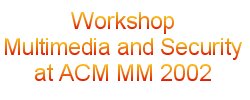



|

|

|

|
Multimedia and Security Workshop at ACM Multimedia 2002, Juan-les-Pins, France | ||||||||||
| . |
|
Multimedia
and Security
Workshop at ACM Multimedia
Juan-les-Pins
on the French Riviera,
Friday, Dec 6th, 2002
Jana Dittmann
1
,
Jessica Fridrich
2
and
Petra Wohlmacher
3
| Introduction Beside the request from content industries for reliable technologies and protocols for protecting the rights of the works they own, there is an increasing interest in manipulation recognition to ensure media data authentication forced by the electronic signature act and in recognition of hidden communication due to recent anti-terrorist activities. One of the (undesired) effects of the universal availability of effective signal processing tools is the possibility to tamper digital multimedia data or to manipulate the media to embed secret information in order to hide the communication without leaving any trace. This puts the credibility of digital multimedia data in doubt. Especially electronic communication, E-Commerce, and even E-Government, where multimedia data is increasingly used, necessitate electronic signatures allowing originator authentication as well as data authentication. Here, there is a great demand for legal recognition of electronic signatures to provide business and civil services within the digital world. Reliable and accurate detection of steganographic communication could prove vital in the future as the society creates defence mechanisms against criminal and terrorist activities. Fast and reliable identification of the stego-product and estimation of the secret message size and its decoding are among the highest ranking requirements formulated by law enforcement. Watermarking technology is recent and still needs further research, development, and coordinated actions for their efficient use in multimedia systems. The goal of the workshop is to set a platform able to identify key issues to be addressed by future research of manipulation recognition for media data authentication as well as to detect hidden communication channels to motivate this research and to establish fruitful relationships with key actors in the European, US, and Asian countries. Objectives
|
The mission of the workshop is to bring together experienced researchers, developers, and practitioners from academia and industry for a discussion of aspects and the impact of digital manipulations and steganographic channels. The workshop reflects the strength and weaknesses of what the multimedia community has to offer to meet the needs of secure multimedia environments. Participants get an excellent overview about what the community has to offer, where the improvements are, and discuss ongoing progress as well as open research problems. This year, we focused on the topics such as but not limited to
|
|
8:00-08:20 |
Jana Dittmann, Jessica Fridrich, Petra Wohlmacher „Session leader introduction of participants: Manipulating the Digital World – Challenges and Legal Aspects of Multimedia Cryptography, Steganalysis, and Digital Watermarking“ |
|
|
08:20-08:40 |
Jessica Fridrich, Miroslav Goljan, Dorin Hogea „Attacking the OutGuess“ |
|
|
08:40-09:20 |
Kamran Ahsan, Deepa Kundur “Practical Data Hiding in TCP/IP“ |
|
| 09:20-9:40 |
Gina Fisk, Eric Weigle, Joshua Neil „On the Limitations of Embedding Data in Immutable Carriers |
|
|
09:40-10:00 |
Jessica Fridrich „Round table wrap-up; discussion amongst the par-ticipants: The importance of steganalysis, open problems, formulation of relevant future research problems“ |
|
|
10:00-10:30 |
Break |
|
|
10:30-10:50 |
Deran Maas, Ton Kalker, Frans Willems, Philips
Research „A Code Construction for Recursive Reversible Data-Hiding“ |
|
|
10:50-11:10 |
Jun Tian „Reversible Watermarking by Difference Expansion“ |
|
|
11:10-11:30 |
Maria Grazia Albanesi, Federico Guerrini „Authentication and Recovery of Digital Images Using Error Correcting Codes“ |
|
|
11:30-12:00 |
Klaus Keus, Claus Vielhauer, Jana Dittmann „Trustworthy User Authentication – a Combination of Handwriting and Electronic Signatures“ |
|
|
12:00-13:00 |
Break |
|
|
13:00-13:20 |
Martin Dietze, Sabah Jassim „The Choice of Filter Banks for Waveletbased Robust Digital Watermarking“ |
|
|
13:20-13:40 |
EeChien Chang, Sujoy Roy „Watermarking with Retrieval Systems“ |
|
|
13:40-14:00 |
Nataša Terzija, Markus Repges, Kerstin Luck,
Walter Geisselhardt „Impact of different Reed-Solomon codes on digital watermarks based on DWT“ |
|
|
14:00-14:30 |
Break with DEMO : Weijie Lu, Kefei Chen |
|
|
14:30-14:50 |
Paul Judge, Mostafa Ammar „The Role of Watermarking in Securing Peer-to-Peer Systems“ |
|
|
14:50-15:10 |
Charistian Neubauer, Frank Siebenhaar, Martin
Steinebach „AAC Bitstream Watermarking Robustness Assessment“ |
|
|
15:10-15:30 |
Yongju Cho, Jinwoo Hong, Jinwoong Kim „Security System Compliant with MPEG-4 IPMPX“ |
|
|
15:30-16:00 |
Break | |
|
16:00-16:20 |
Andreas Pommer, Andreas Uhl „Selective Encryption of Wavelet Packet Subband Structures for Secure Transmission of Visual Data“ |
|
|
16:20-16:40 |
Andreas Pommer, Andreas Uhl „Application Scenarios for Selective Encryption of Visual Data“ |
|
|
16:40-17:00 |
Rüdiger Grimm, Jürgen Nützel „Security and Business Models for Virtual Goods“ |
|
|
17:00-17:30 |
Round table wrap-up; discussion amongst the par-ticipants: The importance of reliable steganalysis, open problems, formulation of relevant future research problems. |
2 Department of Electrical and Computer Engineering
SUNY Binghamton, Binghamton, NY 13902-6000
fridrich@binghamton.edu
3 Regulatory Authority for Telecommunications and Posts
Section Electronic Signature
petra.wohlmacher@regtp.de
| July 2002 |